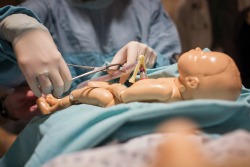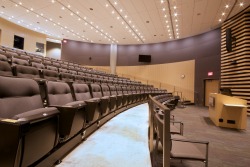Facilities/Teaching Sites
The Department of Obstetrics & Gynecology believes in providing student physicians and residents with the highest-calibre learning tools and resources available. As such, our students benefit from access to a range of educational enhancements and learning tools both on-campus and within our teaching hospitals.
SIM Educational Centre

As Canada's premier simulation centre for women's health, our SIM Centre includes two "simulators"-life-size robotic mannequins that recreate a variety of common and atypical obstetric and gynecological procedures and subsequent complications.
Besides speaking and breathing, these high-tech simulators have a pulse, blood pressure and even drug recognition software that allows them to exhibit the same pharmacological reactions of a human patient. This incredible technology allows students to develop critical hands-on and communication skills and provides a wealth of continuing medical education opportunities for physicians, nurses and other health professionals.
CAMIS and SMRI Surgical Training Centres
The Surgical Medical Research Institute (SMRI) is an advanced surgical facility dedicated to training and support for UAlberta researchers, educators and residents. The institute focuses on integrating modern techniques and state-of-the-art technology to provide solutions for the next generation of surgeons and physicians. SMRI is operated by the University of Alberta's Department of Surgery.
The Centre for the Advancement of Minimally-Invasive Surgery (CAMIS) is dedicated training and educational unit specializing in innovative surgical care. Laparoscopic and robotic techniques and tools are explored to enhance patient care and healing. Residents may also apply for grant funding through the centre to support their research projects. CAMIS is an Alberta Health Services initiative.
Robbins Learning Centre

Since 2012, the Robbins Learning Centre has been an educational hub for our students and the greater medical community. The centre, located on the Robbins Pavillion at RAH, holds a state-of-the-art, 181-seat auditorium as well as three private classroom spaces for smaller gatherings.
Each room is equipped with audio-visual technology that facillitates real-time connectivity with audiences across North America. This incredible technology allows for the sharing of countless high-definition presentations, lectures and demonstrations with other classrooms, operating suites and hospital facilities. The ability to broadcast around the continent opens up and encourages collaborative teaching and learning.
The Robbins Learning Centre also hosts the Royal Alexandra Foundation's Speaking of Health public lecture series and other notable healthcare events throughout the year.
Reproductive and Basic Science Laboratories
Located on UAlberta's main campus, our Reproductive Sciences Laboratories are the hub of basic science research activity in our department. These dynamic labs are divided into four main areas of focus: the Olsen laboratory, the Davidge laboratory, the Riddell laboratory and the Hemmings laboratory.
This collective researches a variety of maternal and perinatal issues, including cardiovascular health, pathophysiology of pregnancy complications, the role of specific lipids on on normal maternal vascular and uterine adaptations to pregnancy, and the causes of preterm labour and preterm birth from gene-environment, predictive and mechanistic perspectives.
Key features within these labs include a working heart system, wire myographs, cell culture and surgical suites, Vevo 2100 Ultrasonography and molecular biology and fluorescence microscopy. The labs are equipped with work stations for students to document their findings as well as shared office spaces for collaborative projects.
Resident Library & Rest Areas
Residents at the Department of Obstetrics and Gynecology have access to library, lounge and rest spaces within our main teaching hospital, the Lois Hole Hospital for Women. Access to dedicated study and rest areas improve the student experience and help keep our residents comfortable while on shift.
The library is a spacious environment where residents can study, prepare for shifts, eat and relax. Public computers, a printer and internet access are available. A reading area and resource library carry a selection of current academic publications for resident use. Lockers are provided to secure personal items.
The resident rest area is a quiet zone in which residents can sleep, rest or shower before or after their on-site rotation. A small communal area and shared resident washrooms are adjacent to the rest areas. A telephone and a computer station is available in each private rest area.